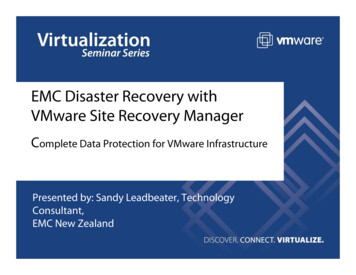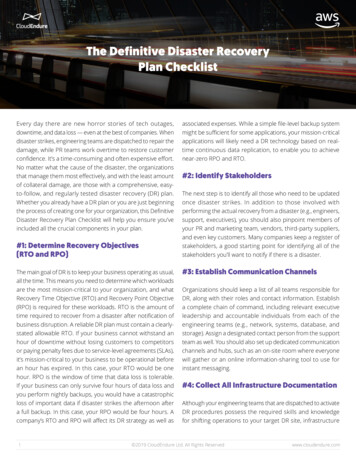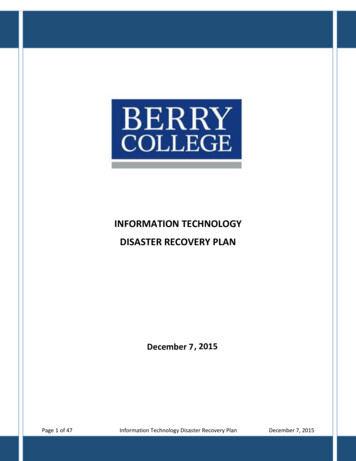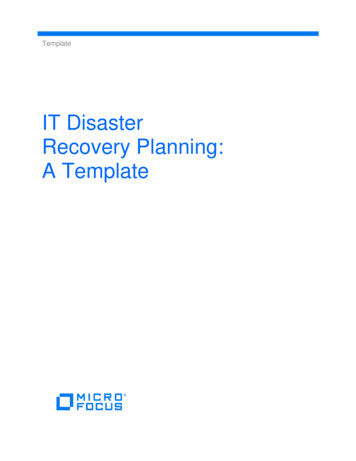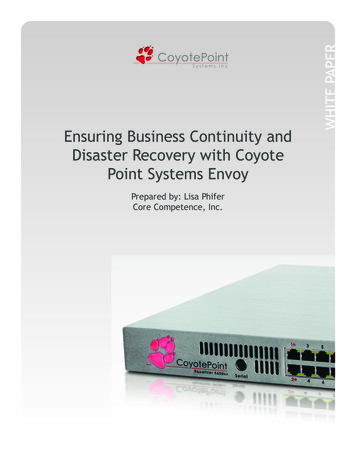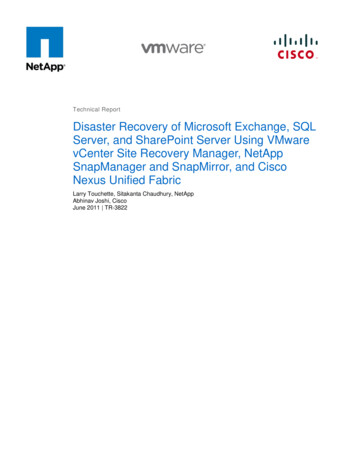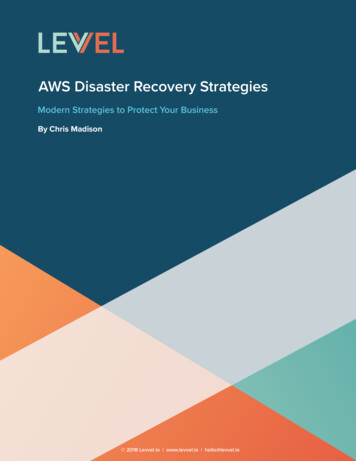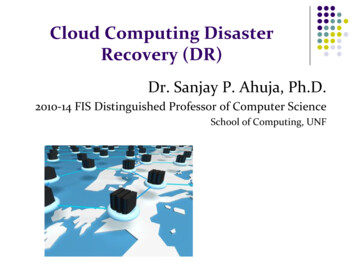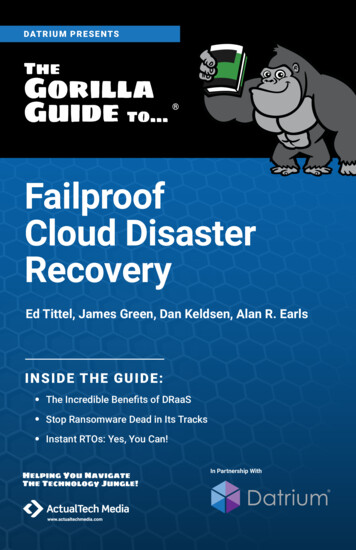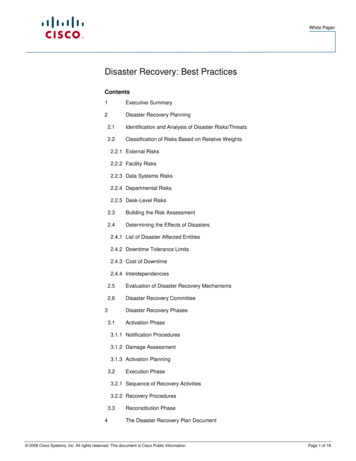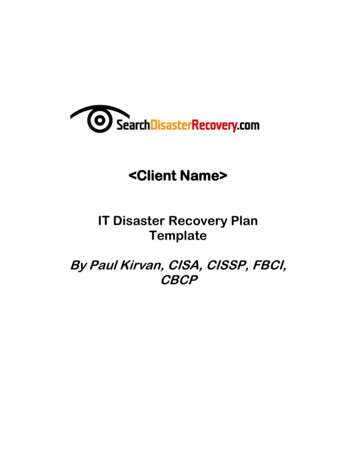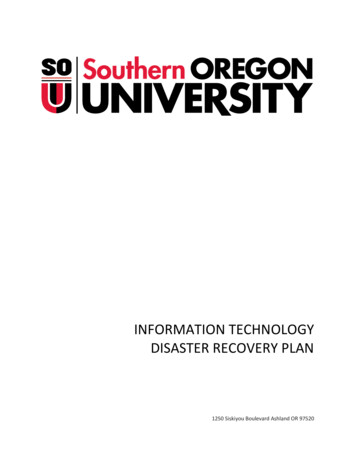
Transcription
INFORMATION TECHNOLOGYDISASTER RECOVERY PLAN1250 Siskiyou Boulevard Ashland OR 97520
Revision HistoryRevision1.01.11.2ChangeInitial Disaster Recovery PolicyPosition and Personnel ChangesMiscellaneous UpdatesDate8/28/201311/7/20169/22/2017Official copies of the document are available at the following locations: Department of Information Technology OfficeOffice and home of the Chief Information Officer1
ContentsRevision History .1Official copies of the document are available at the following locations: .1Contents .2Section 1: Introduction .3Section 2: Scope.3Section 3: Assumptions .4Section 4: Definitions .5Section 5: Teams .75.0.1 Incident Commander .75.0.2 Incident Command Team .75.1 Datacenter Recovery Team.75.2 Desktop, Lab, and Classroom Recovery Team.75.3 Enterprise Systems Recovery Team.85.4 Infrastructure and Web Recovery Team.95.5 Telecommunications, Network, and Internet Services Recovery Team .95.6 Critical Southern Oregon University Contacts .10Section 6: Recovery Preparations .116.1 Data Recovery Information: .116.2 Central Datacenter and Server Recovery Information: .116.3 Network and Telecommunication Recovery Information: .116.4 Application Recovery Information: .126.5 Desktop Equipment Recovery Information: .12Section 7: Disaster Recovery Processes and Procedures .137.1Emergency Response: .137.2 Incident Command Team: .137.3 Disaster Recovery Teams: .157.3.2 Datacenter Recovery Team: .157.3.3 Desktop, Lab, and Classroom Recovery Team: .167.3.4 Enterprise Systems Recovery Team: .167.3.5 Infrastructure and Web Recovery Team: .177.3.7 Telecommunications, Network, and Internet Services Recovery Team: . 177.4 General System/Application Recovery Procedures/Outline:.188.0 Network & Telecommunication Recovery Guidelines: .20Appendix A. IT Contact List .21Appendix B. Southern Oregon University Crisis Management Team Contact List .22Appendix C: Southern Oregon University IT Recovery Priority List .23C.1 IT Infrastructure Priorities: .23C.2 IT System Priorities: .24C.3 Consortium, Outsourced, and Cloud-based IT System Priorities: .25C.4 IT Facility Priorities.26Appendix D: Vendor Information .27Appendix E: Disaster Recovery Signoff Sheet .282
Section 1: IntroductionFaculty, staff and students of Southern Oregon University all rely heavily on the InformationTechnology (IT) infrastructure and services to accomplish their work and as an integral part ofthe learning environment.As a result of this reliance, IT services are considered a critical component in the dailyoperations of Southern Oregon University, requiring a comprehensive Disaster Recovery Plan toassure that these services can be re-established quickly and completely in the event of a disasterof any magnitude.Response to and recovery from a disaster at Southern Oregon University is managed by theuniversity’s Crises Management Team. Their actions are governed by the Southern OregonUniversity Emergency Operations Plan.This IT Disaster Recovery Plan presents the requirements and the steps that will be taken inresponse to and for the recovery from any disaster affecting IT services at Southern OregonUniversity, with the fundamental goal of allowing basic business functions to resume andcontinue until such time as all systems can be restored to pre-disaster functionality.At this time Southern Oregon University possesses a redundant “warm-site” at the HigherEducation Center on our Medford campus for quicker recovery of some operations.This plan is reviewed and updated annually by IT staff and approved by the Chief InformationOfficerA copy of this plan is stored in the following areas: Department of Information Technology Office Office and home of the Chief Information OfficerSection 2: ScopeDue to the uncertainty regarding the magnitude of any potential disaster on the campus, this planwill only address the recovery of systems under the direct control of the Department ofInformation Technology and that are critical for business continuity. This includes the followingmajor areas: Authentication, single-sign-on, and network directory services On-premises enterprise applications (e.g. EMS) Datacenter (Computing Services and HEC, Medford) On-premises website and services Desktop equipment, labs, classrooms Data networks and telecommunications (wired and wireless networks, file services,3
telephony)An increasing number of critical services are no longer hosted by the university, includingsystems crucial for daily activities. The recovery of these systems themselves is beyond thescope of this document and the ability of the IT department, but this plan will address restorationof connectivity and integration with these services. This includes the following major services: Hosted enterprise applications, including Banner (payroll, AP/AR, finance, studentrecords) Learning management system (eThink) Email (Google Apps) Customer Relationship Management (Hobson's Connect)This plan covers all phases of any IT related disaster occurring at Southern Oregon University.These phases include: Incident Response Assessment and Disaster Declaration Incident Planning and Recovery Post incident ReviewSection 3: AssumptionsThis disaster response and recovery plan is based on the following assumptions:Once an incident covered by this plan has been declared a disaster, the appropriate priority willbe given to the recovery effort and the resources and support required as outlined in the ITDisaster Recovery Plan will be available.The safety of students, staff, and faculty are of primary importance and the safeguard of suchwill supersede concerns specific to hardware, software and other recovery needs.Depending on the severity of the disaster, other departments/divisions on campus may berequired to modify their operations to accommodate any changes in system performance,computer availability and physical location until a full recovery has been completed.Information Technology will encourage all other departments to have contingency plans andBusiness Continuity Plans for their operations, which include operating without IT systems foran extended period of time.The content of this plan may be modified and substantial deviation may be required in the eventof unusual or unforeseen circumstances. These circumstances are to be determined by thespecific Disaster Recovery Teams under the guidance and approval of the Incident Commanderand Incident Command Team.4
Section 4: DefinitionsBackup/Recovery Files: Copies of all software and data located on the central servers, which areused to return the servers to a state of readiness and operation that existed shortly prior to theincident/disaster.Catastrophic Disaster: A catastrophic disaster will be characterized by expected downtime ofgreater than 7 days. Damage to the system hardware, software, and/or operating environmentrequires total replacement / renovation of all impacted systems.Warm Recovery Site: Alternate datacenter which has adequate power and networkinginfrastructure to support the critical IT systems used by the university. A cold site does not havebackup servers and other IT equipment and software already in place. SOU has a designatedwarm recovery site at the Higher Education Center in Medford, Oregon.Datacenter Recovery: Individuals responsible for the establishment of an operational datacenter,either by returning the primary center to operational status or by bringing a cold site online foruse.Desktop, Lab, and Classroom Recovery Team: Individuals responsible for the recovery andtesting of desktop computers and services, classrooms, and labs in the affected areas at SouthernOregon University.Disaster Recovery Team: The DRT is a team of individuals with the knowledge and training torecover from a disaster.Disaster: Any IT incident which is determined to have potential impacts on the businesscontinuity and ongoing operations of Southern Oregon University.Crisis Management Team: The CMT is the first to respond to an incident, to secure and containthe situation. The CMT may consist of university personnel, firefighters, police, security, andother specialized individuals.Equipment Configuration: A database (either soft or hard copy) which documents theconfiguration information necessary to return any IT hardware (server, network, desktop) to predisaster configurations. This includes hardware revisions, operating system revisions, and patchlevels.Incident Command Headquarters: Location where the ICTs meet and coordinate all activitieswith regard to assessment and recovery. For the IT Department, the headquarters are located at: Primary: Computing Services 121 Secondary: Computing Services 224 Backup 1: Churchill Hall 228 Backup 2: Higher Education Center 226Incident Command Team: The ICT is a group of IT individuals with combined knowledge and5
expertise in all aspects of the IT organization. It is the responsibility of the ICT to perform theinitial assessment of the damage, to determine if a formal “disaster” declaration is required andto coordinate activities of the various IT DRTs.Incident Commander (IC): The Incident Commander leads all efforts during the initialassessment of the incident, in conjunction with the Incident Command Team (ICT). If a disasteris declared, the IC is responsible for overall coordination of all IT related recovery activities. ForSouthern Oregon University, the Incident Commander is the Chief Information Officer.Incident: Any non-routine event which has the potential of disrupting IT services to SouthernOregon University. An incident can be a fire, wind storm, significant hardware failure, flood,virus, Trojan horse, etc.Major Disaster: A major disaster will be characterized by an expected downtime of more than48 hours but less than 7 days. A major disaster will normally have extensive damage to systemhardware, software, networks, and/or operating environment.Infrastructure and Web Recovery Team: Individuals responsible for the recovery and testing ofinfrastructure systems at Southern Oregon University including Active Directory, DNS, email,server virtualization, and web services. In the cases where these services are hosted offpremises, this team is responsible for re-establishing connectivity, authentication, and integrationof those systems.Minor Disaster: A minor disaster will be characterized by an expected downtime of no morethan 48 hours, and minor damage to hardware, software, and/or operating environment fromsources such as fire, water, chemical, sewer or power etc.Enterprise Applications Recovery Team: Individuals responsible for the recovery and testing ofBanner and other enterprise applications. For those systems hosted off-premises, such asBanner, this team is responsible for re-establishing connectivity, authentication, and integrationof those systems.Routine Incident: A routine incident is an IT situation/failure that is limited in scope and is ableto be addressed and resolved by a specific team or individual as part of their normal dailyoperations and procedures.Network and Telecommunications Recovery Team: Individuals responsible for the recovery andtesting of data and voice networks.Web Services: All services related to Southern Oregon University's Internet and intranet webactivities and presence. The primary web service provided by the university is the homepage atwww.sou.edu and our portal at my.sou.edu.6
Section 5: Teams5.0.1 Incident CommanderChief Information OfficerHome Phone:Cell Phone:5.0.2 Incident Command TeamChief Information OfficerManager, User SupportManager, Infrastructure ServicesManager, Information SystemsManager, Classroom and Media Services5.1 Datacenter Recovery TeamAll Contact Information is located in Appendix AThe Datacenter Recovery Team is composed of personnel within the Information Technologydepartment that support the university’s central computing environment and the primarydatacenter where all central IT services, the Networks Operations Center (NOC) and othercentral computing resources are located. This team also supports the secondary datacenter,located at the Higher Education Center in Medford. The primary function of this working groupis the restoration of the existing datacenter or the activation of the secondary datacenterdepending on the severity of the disaster. This team’s role is to restore the datacenter to acondition where individual recovery teams can accomplish their responsibilities with regard toserver installation and application restoration.The team should be mobilized only in the event that a disaster occurs which impacts the abilityof the existing central computing facility to support the servers and applications running there.The team lead has the responsibility to keep the IT Incident Commander up to date regarding thenature of the disaster and the steps being taken to address the situation. The coordination of thisrecovery effort will normally be accomplished prior to most other recovery efforts on campus ashaving a central computing facility or a functioning secondary site is a prerequisite for therecovery of most applications and IT services to the campus.Team Lead:Team Members:Manager, Infrastructure ServicesSystem Administrators (2)Desktop Systems AdministratorNetwork Communications Technicians (2)5.2 Desktop, Lab, and Classroom Recovery TeamAll Contact Information is located in Appendix AThe Desktop, Lab, and Classroom Recovery Team is composed of personnel within the7
Information Technology department that support desktop hardware, client applications,classrooms, and labs. The primary function of this working group is the restoration of SOU'sdesktop systems, classrooms, and labs to usable condition. During the initial recovery effort, theteam is not responsible for restoration of any data the user may have on their desktop computer.Southern Oregon University recommends all users store data files on the file servers, which arebacked up nightly, to support data recovery.The team should be mobilized in the event that a significant interruption in desktop, lab, orclassroom services has resulted from unexpected/unforeseen circumstances and requiresrecovery efforts in excess of what is experienced on a normal day-to-day basis.The team lead has the responsibility to keep the IT Incident Commander up to date regarding thenature of the disaster and the steps being taken to address the situation. The coordination of thisrecovery effort will be accomplished with other recovery efforts on campus by the IT IncidentCommander.Team Lead:Team Members:Manager, User ServicesManager, Classroom and Media ServicesDesktop Systems AdministratorComputing Coordinators (7)Lab and Student Computing CoordinatorEquipment Systems Specialist5.3 Enterprise Systems Recovery TeamAll Contact Information is located in Appendix AThe Enterprise Systems Recovery Team is composed of personnel within the InformationTechnology department that support Banner and other enterprise systems. The primary functionof this working group is the restoration of all modules of Banner applications to the most recentpre-disaster configuration in cases where data or operational loss is significant. In less severecircumstances the team is responsible for restoring the system to functional status as necessitatedby any hardware failures, network outages, or other circumstances that could result in diminishedsystem operation or performance.The team should be mobilized in the event that Banner or the other enterprise systems experiencea significant interruption in service that has resulted from unexpected/unforeseen circumstancesand requires recovery efforts in excess of what is experienced on a normal day-to-day basis.This team will coordinate its activities with the OUS 5th Site, which is responsible for hosting,managing, and supporting Banner and Cognos and their respective Oracle databases.The team lead has the responsibility to keep the IT Incident Commander up to date regarding thenature of the disaster and the steps being taken to address the situation. The coordination of theenterprise systems recovery effort will be accomplished with other recovery efforts on campusby the IT Incident Commander.8
Team Lead:Team Members:Manager, Information SystemsManager, Infrastructure ServicesProgrammer/Analysts (4)Web Programmer/AnalystSystem AdministratorComputing Coordinators supporting affectedareas (business services, payroll, enrollmentservices, etc.)Key Business Unit Personnel as needed bytype of incident (payroll clerk, accountant,registrar, etc.)5.4 Infrastructure and Web Recovery TeamAll Contact Information is located in Appendix AThe Infrastructure and Web Recovery Team is composed of personnel within the InformationTechnology department that support the university’s network
Disaster: Any IT incident which is determined to have potential impacts on the business continuity and ongoing operations of Southern Oregon University. Crisis Management Team: The CMT is the first to respond to an incident, to secure and contain the situation. The CMT may consist of university personnel, firefighters, police, security, and
